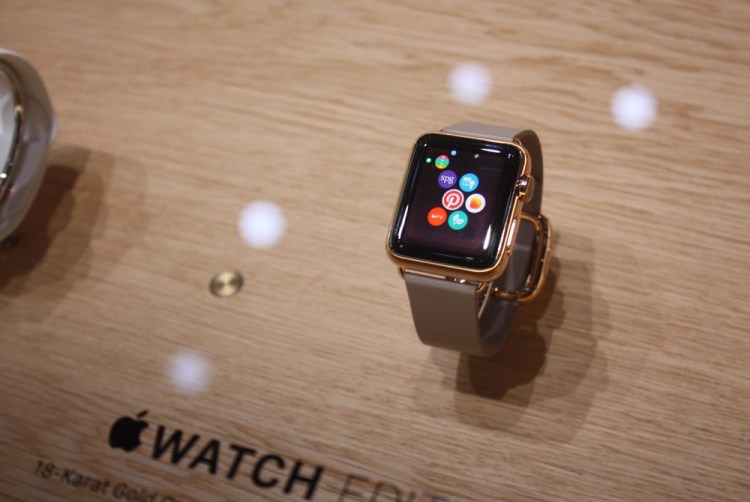The year is 1989 and our esteemed hero, Marty McFly, has just touched down in a fictional Hill Valley of 2015 to save his kids from his childhood nemesis. Back in the ’80s, when the Back to the Future franchise first took the world by storm, the incredible technologies presented there seemed more of a pipe dream fantasy than prophetic sci-fi.
Fast forward to the real 2014. While the Back to the Future crew did get some things right, they definitely missed the mark on the technology that has the whole (tech) world obsessed — wearables.
As wearable technology slowly matures beyond fitness and health to tackle business and personal use, the challenge of inputting language into a wearable is quickly coming to the forefront of the discussion. While the oh-so-popular QWERTY keyboard has doggedly survived the communication revolution, the obvious spatial constraints presented by a smartwatch or smart glasses present some serious obstacles.
As is often the case with developers, there are already a number of different schools of thought regarding the best approach for text input in wearables. While some are already implemented, others are still in their infancy.
The Traditionalists aka QWERTYphiles
While some of the Traditionalists head toward touch keyboards, others are heading to virtual ones. No matter the implementation, with Traditionalists there is no compromise regarding the layout — it’s QWERTY for life in this club. Today, you can find several examples of these types of keyboards, from clothes with a built-in wireless keyboard; a small-scale minimized keyboard such as Minuum’s that you can enlarge or minimize to access different keys, and even a glove that is used as a wearable keyboard for QWERTY-based input.
The Augurs aka Predictivephiles
The challenges associated with displaying even a micro QWERTY keyboard on a wearable served as the inspiration for the evolution of the Augur school of thought. Advanced, adaptive text prediction software is already readily available in most smartphone keyboards, making its implementation in wearables an enticing option. Text prediction software analyzes text as it’s inputted, to identify (and present the user with) the word most likely to follow the one that’s being written. Adaptive features enable most text prediction software to learn users’ writing styles with time, so that names and styles are implemented into the engine and then offered as predictive text. This enables wearable developers to offer smaller keyboards with fewer keys, as the software should pick up on the word (and next word) being written after only a few letters.
Other predictive implementations include a doodling keyboard such as Inkboard that allows the user to tap or draw sketches on the devices digital screen and share her creations with her friends. There are even reports of an emoji-only keyboard that enables people to convey their feelings without actually having to describe them with words.
The Dictators aka VPAphiles
The final school of thought touts voice-based input as the most effective form of interacting with wearable devices. Intelligent, virtual personal assistants (VPAs) leverage voice recognition technology to dictate text to their device. The text then becomes “actionable” when relevant intentions are extracted by the software, enabling this feature to send messages, schedule meetings, place phone calls, and perform many other tasks just by speaking.
Nuance is already well ahead of the game in this field, partnering with companies like Samsung and Omate for the companies’ wearables. Demoes have shown that activities like sending emails, texts, and updating calendars with events can be done on a PA-enabled smartwatch in less than half the time it would take to perform the same function by tapping on a tiny screen.
Although many believe that Apple’s Siri fell short of expectations, the new Google Now VPA has definitely raised the bar. Google Now doesn’t just fetch information on command but attempts to anticipate the user’s needs by retrieving information even before it has been requested.
While seemingly the optimal solutions for wearables, VPAs have already been around for quite some time without denting the popularity of texting. Another interesting facet to consider is that some people might feel uncomfortable vocalizing what was once an inherently private interaction.
It seems that typing on a traditional keyboard as a means of communication is not necessarily what our future holds. Instead wearable devices will be operated by an amalgamation of all of the options discussed — voice recognition, sentence/word based predictive software and perhaps even some sort of mutated QWERTY layout.
Just take a minute and look around the next time you’re waiting for your train or bus; people are hunched over their electronic devices like zombies. Perhaps Spike Jonze’s vision of the future in the sci-fi movie ‘Her’ wasn’t that far-fetched? He portrayed our future as one where people no longer communicate with each other but rather prefer connecting to their operating system. We can’t blame them, what with wearables being available 24/7 for every possible need and being capable of listening to and understanding our problems, they probably know us better than anyone else.
Maoz Shacht is the CEO of Ginger Software, a mobile keyboard app developer.


